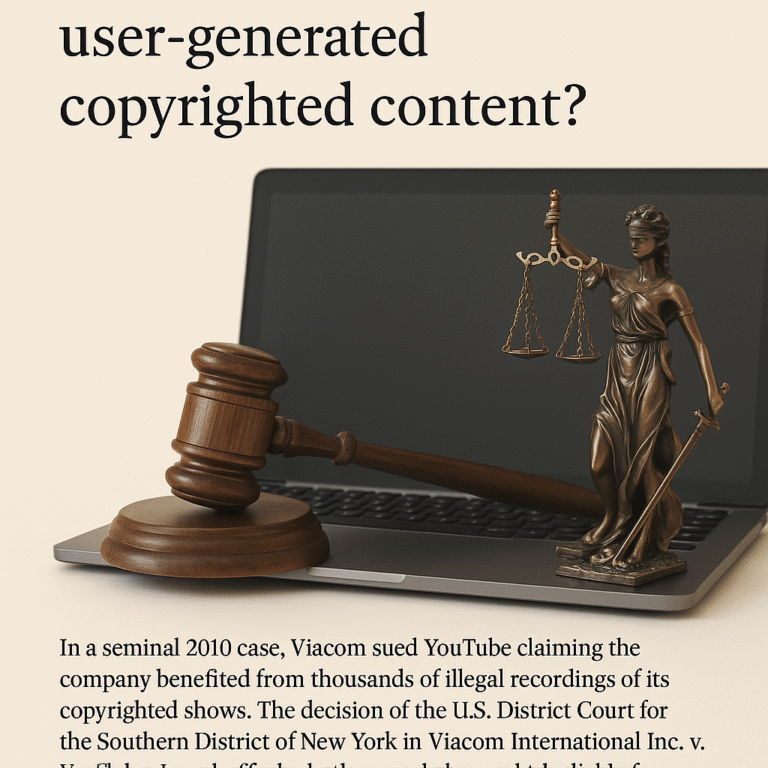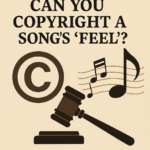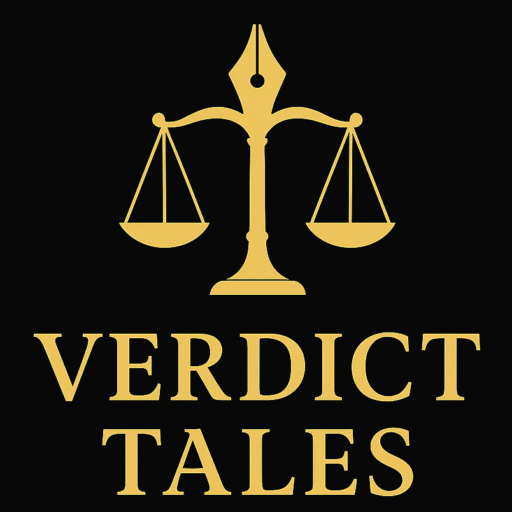In a seminal 2010 case, Viacom sued YouTube claiming the company benefited from thousands of illegal recordings of its copyrighted shows. The decision of the U.S. District Court for the Southern District of New York in Viacom International Inc. v. YouTube, Inc. clarified whether a website might be liable for user-uploaded copyrighted information, therefore changing the digital scene for platforms and content creators.
Case Background
Imagine it: in 2007 the internet is humming. Go-to site for cat videos, song covers, and—increasingly—TV show clips is YouTube, a tiny startup recently acquired by Google. Media behemoth Viacom, behind MTV and Nickelodeon, is raging. Finding tens of thousands of their copyrighted works—think of SpongeBob SquarePants episodes and The Daily Show segments—uploaded without authorization and accumulating millions of views crushed their heart. To Viacom, this was a direct attack on their bottom line, not only piracy.
New York-based Viacom was a powerhouse in the entertainment business creating early 2000s pop culture defining material. Conversely, YouTube was the wild west of the internet, a forum where anybody could post films for free on servers churning out over 24 hours of fresh material every minute. There was going to be conflict. Viacom said YouTube embraced the pirated material even though it boosted user traffic and ad income. It also knew about it. Their claim is: profiting off pilfers, YouTube was culpable for direct, vicarious, and contributory copyright infringement, turning a blind eye.
Reflecting a larger contradiction in the digital age—who’s accountable when users breach the law online—the case developed in New York, a center for both journalism and technology. Viacom insisted on responsibility, claiming “massive piracy” was made possible by lax YouTube standards. YouTube said that the Digital Millennium Copyright Act (DMCA) guards it and that it was just a platform, not a gatekeeper. The central question of the case—can a website be liable for user-uploaded copyrighted content—would define the course of the internet going forward.
Legal Activities
Judge Louis L. Stanton oversaw the high-stakes confrontation in the U.S. District Court for the Southern District of New York. Viacom contended that YouTube neglected quick response after having “actual knowledge” of extensive infringement. Their lawyers highlighted internal YouTube emails implying the site knew illegal content was a draw, increasing ad income. Viacom’s data includes assertions that hundreds of millions of people illegally saw “tens of thousands” of their videos. Seeking partial summary judgment, they claimed YouTube was purposefully profit-driven from piracy rather than merely careless.
The defense of YouTube rested on the DMCA’s “safe harbor” clause, 17 U.S.C. § 512(c), which, under specific circumstances, releases service providers from liability for user-uploaded content. Their lawyers said YouTube cooperated by designating an agent to get takedown notifications and quickly deleting material upon notification. Moving for summary judgment, they claimed that Viacom’s assertions of general awareness fell short of the specific knowledge of infringing items required by the DMCA. YouTube stressed that almost all of the 100,000 videos Viacom sent a mass takedown notice for on February 2, 2007, were deleted by the next business day.
Key evidence comes from internal records and professional opinions. The lawyers for Viacom emphasized the early years of YouTube, when founders reportedly refrained from censoring popular infringing clips in order to keep consumers hooked. YouTube responded with proof of its compliance measures, including the “Claim Your Content” tool Audible Magic used to screen copyrighted material. The court had to assess whether a website is accountable for user-uploaded copyrighted content depending on general awareness of infringement or must the platform have specific, item-by-item knowledge?
Court Decision and Justifications
The district court decided on June 23, 2010, that YouTube qualified for the safe harbor protection against Viacom’s assertions of direct and secondary copyright infringement, therefore approving YouTube’s move for summary judgment. Denying Viacom’s request, the court confirmed that given the facts, YouTube was not liable for user-posted copyrighted material. With careful reading of the DMCA and its legislative intent, the court ruling rested on the following main points:
-
The court decided that rather than a general awareness of widespread piracy, the terms “actual knowledge” and “facts or circumstances from which infringing activity is apparent” in the DMCA refer to particular and identifiable instances of infringement. Viacom’s proof of YouTube’s general awareness was insufficient as the DMCA burdens copyright owners with identification of illegal content.
-
Quick removal of material by YouTube following DMCA-compliant takedown notices—such as Viacom’s 2007 mass notice—showcased adherence to Section 512(c)(1)(A)(iii). The court observed the effectiveness of the DMCA’s notice-and-takedown procedure, which, in this case, operated as expected.
-
Control: The court decided that YouTube lacked a “financial benefit directly attributable to the infringing activity” if it possessed the “right and ability to control” such activity (§ 512(c)(1)). Control calls for item-specific information, something Viacom lacked proof of before notifications were sent.
-
Broad Definition of Storage: Viacom said that YouTube’s actions—including copy, formatting, and video display—went beyond “storage,” covered by the DMCA. The court disagreed, concluding that these purposes fit the scope of the safe harbor and were incidental to user-directed storage.
-
No Duty to Monitor: Section 512(m) of the DMCA specifically notes that service providers are not obligated to check their systems for infringing behavior. The court denied Viacom’s allegation that YouTube’s inaction in aggressively policing material created liability for user-uploaded copyrighted materials.
Drawing on Senate and House studies highlighting the objective of the DMCA—balancing copyright protection with internet innovation—the court’s analysis depended on legislative history. The court guaranteed platforms like YouTube could run free from ongoing accountability by demanding particular information, as long as they followed takedown notices. The court ruling answered the fundamental question—can a website be accountable for user-uploaded copyrighted content—with a resounding “not without specific knowledge.” General awareness of infringement does not strip a website of safe harbor protection.
Ideas and Final Thought
Offering vital lessons for platforms, content creators, and the legal system, the Viacom v. YouTube court ruling is a pillar of the digital era. It provides clear guidelines for liability, therefore addressing the issue of whether a website might be accountable for user-uploaded copyrighted materials. We can thus learn as follows:
-
The verdict tells websites: obey the DMCA’s guidelines—designate an agent, remove information immediately upon notification—and you’re protected. Not police. You are not obliged, nevertheless, to act as investigator searching your platform for piracy. This balance honors copyright and stimulates creativity.
-
Content makers such as Viacom have to regularly monitor platforms and send certain takedown notifications as copyright owners bear the responsibility. The court’s ruling permits copyright holders to defend their work but calls for accuracy to avoid nebulous or too broad assertions.
-
The part the judicial system plays in clarity: The legal system resolved a difficult question so guaranteeing the safe harbor of the Copyright Directive is not compromised by broad claims. This precedent directs next decisions, preserving a structure whereby platforms may flourish free from burdens of obligation.
Why should the typical reader find this case important? If you have ever posted a video, aired a show, or clicked an advertisement, this ruling influences your online life. It guarantees that sites like YouTube stay dynamic venues for content distribution free from paralysis by lawsuits. Your favorite sites can restrict uploads or close completely without the safe harbor, therefore limiting creativity. The question—can a website be liable for user-uploaded copyrighted content—affects the accessibility and variety of the internet.
One of shared duty is the moral lesson. When alerted, platforms have to behave responsibly; copyright owners have to be alert rather than expecting automatic enforcement. Legally, the case emphasizes the continuing significance of the DMCA, a legislation written in 1998 currently controlling our digital environment. For the general public, it serves as a reminder that the freedom of the internet comes with guidelines meant to balance innovation, business, and art.
The Viacom v. YouTube court decision shaped our online interaction—not only resolved a conflict. Responding to whether a website can be liable for user-uploaded copyrighted content protects platforms and holds them accountable, therefore ensuring the internet stays a venue for both creators and users. This court ruling stays a lighthouse guiding the careful dance between technology and copyright as we negotiate an always changing digital terrain.
Note: This blog is a paraphrase étude or translation of the original court ruling, hence prone to mistakes. Regarding any legal reference, kindly review the original decision.




